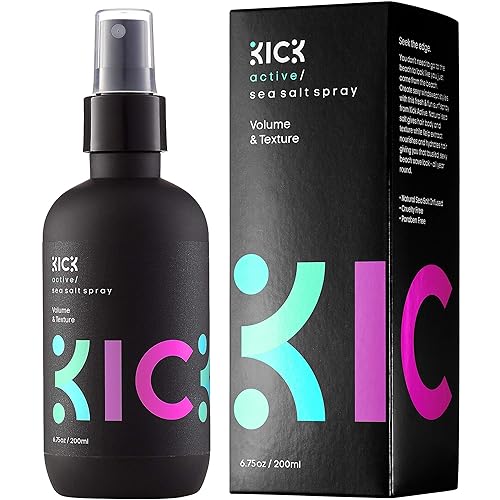Localized Frizz: Why Some Parts of Hair Get Frizzy?
Updated on
This post may contain affiliate links. As an Amazon Associate, we may earn from qualifying purchases.
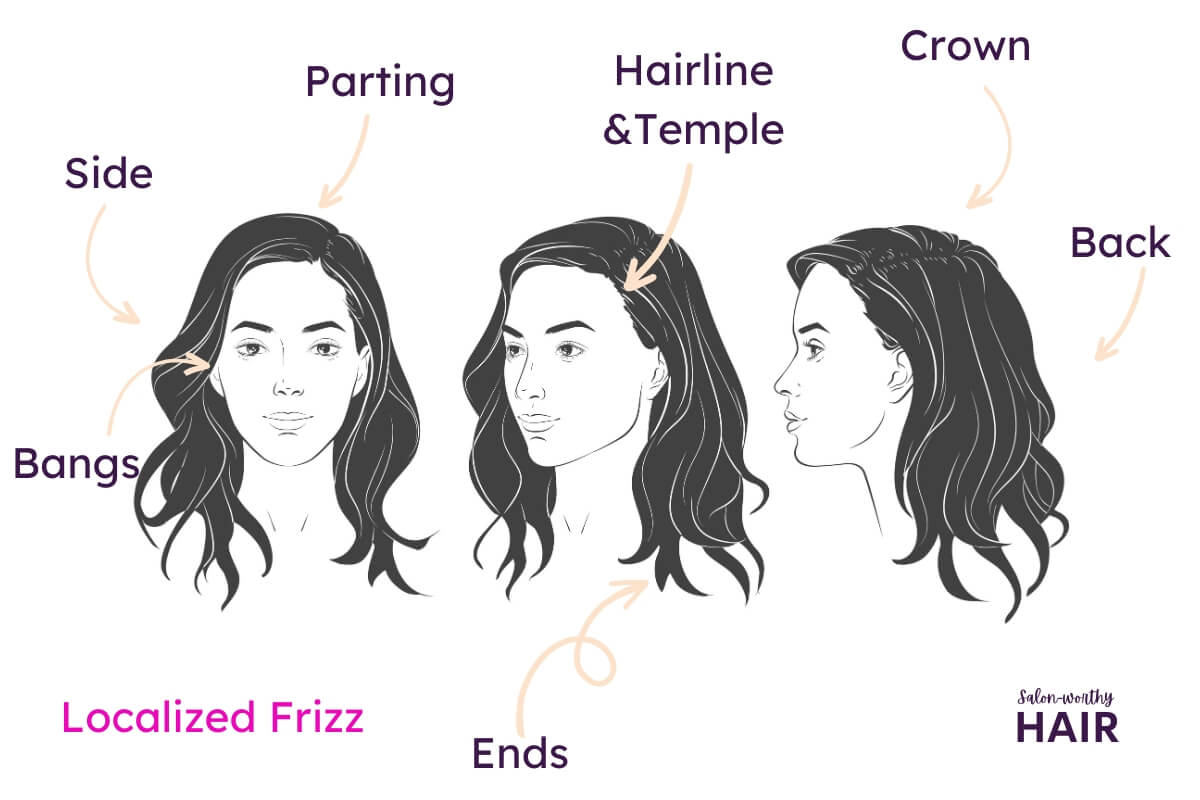
Hair on different parts of the head has varying textures, lengths, smoothness, and growth patterns that can manifest as localized frizz.
These parts include:
- The crown (top of the head),
- Partings, the ends (tips),
- The sides framing the face,
- The hairline and temples,
- Bangs, edges,
- The nape of the neck and back of the head,
- The top layer and under layers.
The inconsistencies and lack of smoothness can create patches of hair that are frizzier than others.
Frizzy hair disrupts the uniform and smooth appearance of the hair. When only specific sections of hair become frizzy, simply using an anti-frizz shampoo or conditioner might not be enough. Localized frizz demands targeted products and specialized care, as general solutions may not effectively stop and prevent frizz in the affected areas.
To manage hair that frizzes selectively in certain areas, identifying the problem region and understanding its underlying cause is essential. By pinpointing the source of the problem, you can then introduce tailored treatments, products, and styling techniques to manage it effectively.
Here are the reasons why some parts of hair get frizzy and what you can do to tame them:
Table of Contents
- Frizzy Hair on the Crown (Top of Head)
- Frizz Along the Parting
- Frizz on the Ends
- Frizz on the Sides Hair
- Frizz on the Hairline
- Frizz on the Temples
- Frizzy Bangs
- Frizzy Edges
- Frizz at the Nape of the Neck
- Frizz at the Back of the Head
- Frizz on the Surface of the Hair
- Frizzy Hair Underneath
- Why Only One Patch Of Hair Gets Frizzy?
- Frizzy Hair in Parts Requires Targeted Products
Frizzy Hair on the Crown (Top of Head)
Frizz on the crown of the head occurs because hair in that area is the most exposed and subject to most styling endeavors.
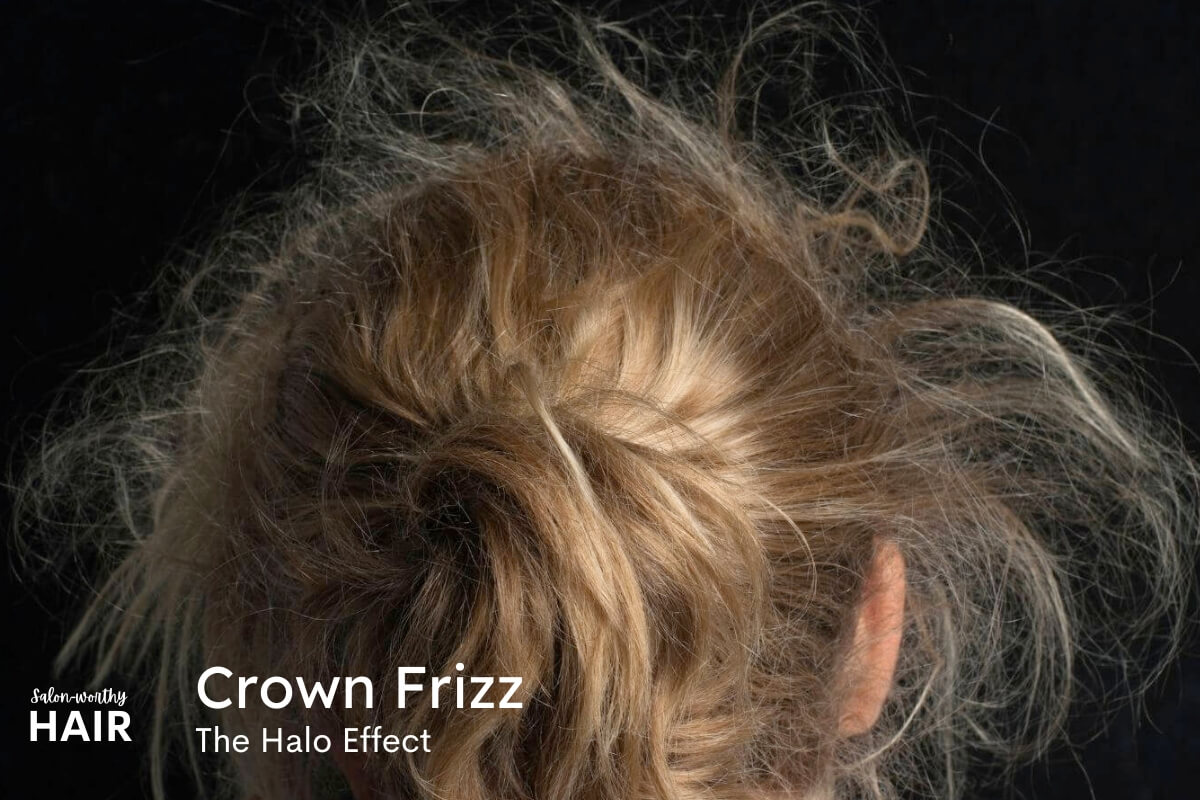
The crown of the head, also known as the vertex, is the curving area at the back of the head. Its elevated position exposes it to sun, rain, and humidity more than other areas of the scalp, consequently degrading the crown hair’s cuticles over time.
Hair cuticle degradation is further exacerbated by chemical hair treatments like coloring and bleaching, in addition to heat styling, frequent manipulation, and excess product application. Over time, this combination of environmental exposure and repeated chemical and mechanical damage can cause the hair cuticles on the crown to lift and separate, leading to dryness, frizz, and fractures.
The weakened cuticle structure makes the hair prone to breakage, leading to uneven lengths across the crown. As a result, the crown hair becomes difficult to control and appears dry, flaky, and damaged, with stray hairs floating around in a halo-like pattern. This halo effect is commonly known as halo frizz or crown frizz.
The crown of the head often serves as the foundation for most hairstyling efforts. Consequently, frequent exposure to styling tools, products, and manipulation through hairstyling can make this area more susceptible to damage and breakage, leading to frizz at the crown. Regular handling can compromise the hair’s moisture balance, exacerbating frizziness in this region.
To help smooth frizzy hair on the crown, use a lightweight serum or oil that contains silicone or smoothing agents. Silicone adds a smooth coating on the hair shaft, reducing friction and chances of breakage when styling. It also adds an extra layer of protection against environmental elements like sun, wind, and humidity.
Redken Frizz Dismiss Hair Serum
Frizz Along the Parting
Frizz at the parting arises from frequent style adjustments, excessive product use, loss of natural oils, scalp problems, tight hairstyles, and conflicting hair growth patterns.
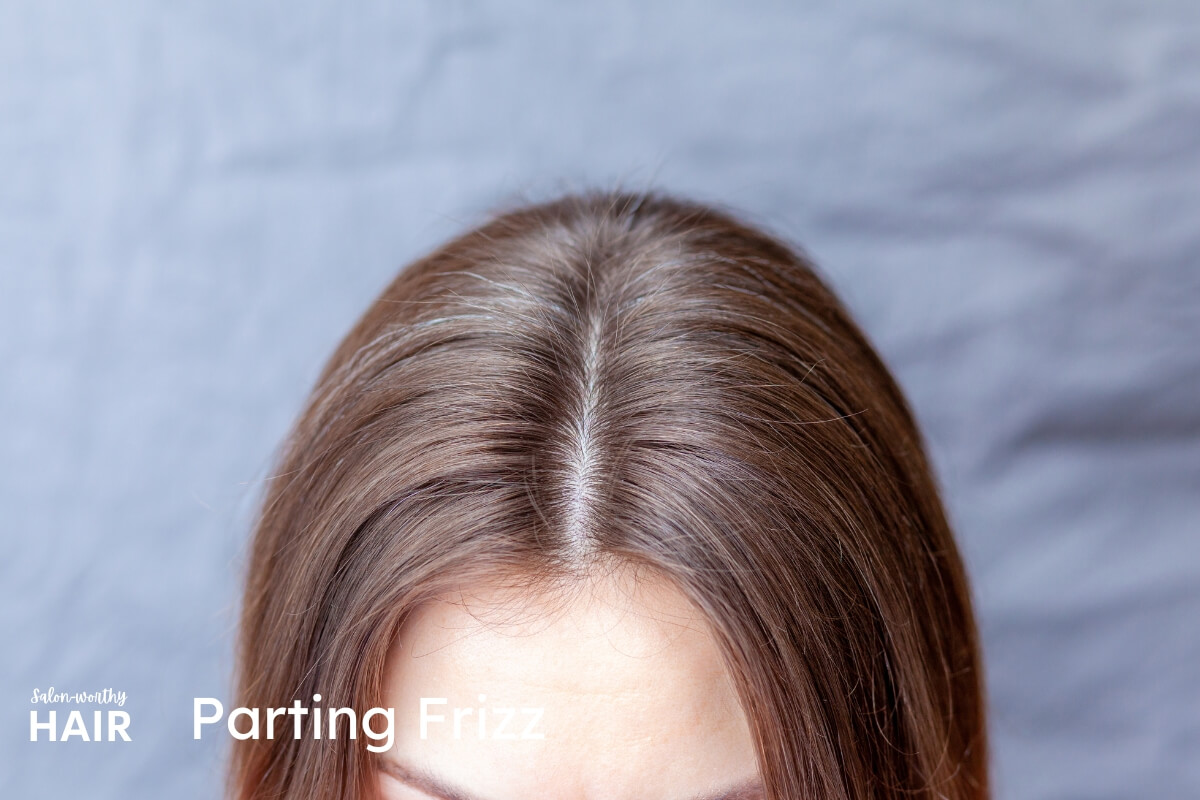
Parting is the separation of hair on the scalp revealed by a line or multiple lines. The line (or lines) are the clear and visible division or separation created in the hair, partitioning it into distinct sections to create symmetry or asymmetry. The boundary delineates one section of hair from the other, which is noticeable when the parting is neat and defined. Parting lines can be straight, zig-zag, curved, diagonal, or undefined, depending on one’s preferred hairstyle.
Hairstyle adjustments around the part line involve changing the part’s location or direction to enhance the hairstyle’s frame and shape. Adjusting the part line can also add volume and visual interest in that area. Additionally, adjusting the depth of your part between shallow and deep makes a difference in how much scalp is exposed, potentially making hair appear thinner on top with a deeper part.
Regularly changing the direction or position of your hair parting can result in frizziness in that area by disrupting the hair’s natural alignment. Hair has a natural direction and fall, influenced by how it’s styled and set over time. Altering the natural alignment can stress the hair shafts, leading to breakage. Continually adjusting the parting exerts traction on the hair roots. The repeated pulling and tension weaken the hair fibers, leading to thinning and the appearance of short, broken hair strands that manifest as frizz.
The hair along the part line is a natural landing spot for hairstyling products like sprays, mousses, and dry shampoos.
Many people touch up their hairstyles along the part line throughout the day, often adding more products. The excess products can create buildup of natural oils and product residues. Without regular deep cleansing from a clarifying shampoo, buildup can coat the hair along the part line, clog the follicles, and prevent the even distribution of sebum from the scalp. Lack of moisture, coupled with the limpness of the hair at the part line, can lead to “parting frizz.” This condition makes the hairs appear fuzzy with flyaways, diminishing the clarity of the parting line.
Stripping natural oils from the scalp and hair through over-washing or harsh shampoos can directly impact frizz along the parting line. The parting and hairline are often the first areas to come into contact with shampoo. As a result, they are exposed to the cleansing agents longer than the rest of the hair, causing dryness and frizz.
While many people vigorously scrub the parting line of their scalp to ensure cleanliness, thinking it’s dirtier due to more exposure, this approach can be counterproductive. Applying a higher product concentration might strip away more sebum, disrupting the natural oil balance to create frizz.
The hair along the parting line is more exposed than other areas of your hair. This direct exposure makes the hairs at the parting and hairline more vulnerable to damage from environmental factors like UV rays, humidity, pollution, and wind. The increased exposure leaves these delicate hairs more susceptible to frizzing and damage from external stressors. Unlike the rest of the hair, the parting line does not have extra layers of hair to protect it from the elements. Therefore, the parting tends to be more reactive to external factors and more prone to frizz than other hair parts.
Tight hairstyles can directly contribute to frizz along the parting line due to the physical stress they exert on the hair. Hairstyles like ponytails, braids, or buns strain the hair, especially the parting line, which is already sensitive and exposed. This tension increases the vulnerability of these delicate strands, leading to easier breakage, frizz, and irregular hair lengths.
And finally, the head has areas of varying natural growth patterns. Parting against or through these areas leads to frizz from forcing the hair into an unnatural direction.
To tame and prevent frizz along the hair partings:
Limit style adjustments along the parting line.
Use gentle finger-combing instead of brushes. Gentle finger strokes provide a more delicate and controlled styling method than brushes. Finger combing also allows for the natural distribution of scalp oils along the hair shaft, providing a smoother finish and reducing the risk of frizz.
Frizz on the Ends
Hair ends are prone to frizz due to age, diminished natural oils, environmental exposure, and infrequent trims.
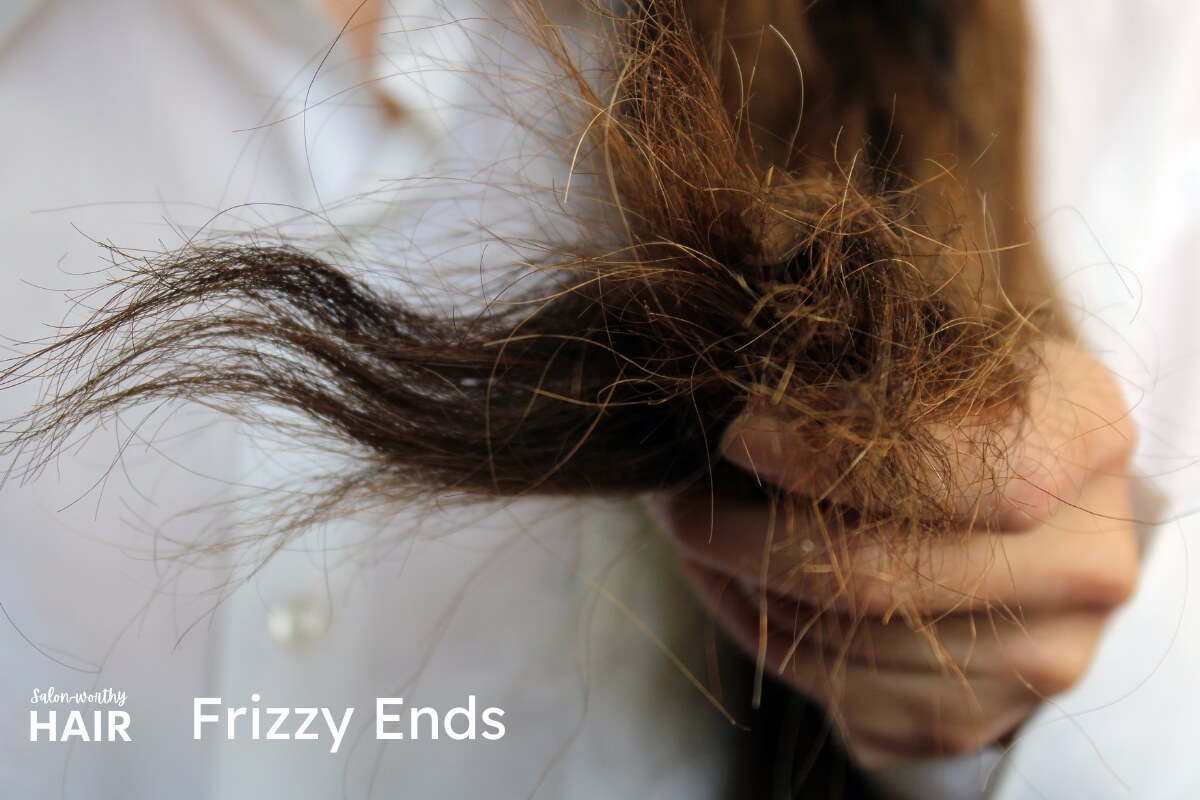
The ends of the hair are the tips furthest from the scalp and are the oldest parts of the hair strand. Because of their age, they have been exposed to weathering and styling routines the longest. Consequently, these tips undergo more wear and tear from hair styling routines.
The hair tips undergo significant mechanical stress from brushing, detangling, straightening, blow-drying, and chemical treatments like coloring and bleaching. Consequently, these tips develop weaker structures, making them susceptible to splitting and frizz.
The hair ends also receive less natural oils due to their distance from the scalp. Without adequate natural conditioning, the ends can become dry, a precursor to frizz.
The ends are prone to split ends and breakage. When the protective layer of hair (the cuticle) is damaged, the inner layers get exposed, leading to fractures and split ends. These split ends make the hair uneven, contributing to a frizzy appearance.
Regular trims help combat frizzy ends by removing splits and damaged tips that can exacerbate frizz as they travel up the hair shaft.
If you can’t schedule regular trims, consider using a split ends serum. This anti-frizz product is a temporary remedy that binds and smoothens frayed hair fibers. The serum forms a protective seal around damaged ends, preventing further splitting and frizz.
GHD Split Ends Therapy
Frizz on the Sides Hair
Hair that falls on either side of the face, from the temples and past the ears to the jawline and beyond, can experience frizz due to habitual touching, tucking, twirling of the hair, shorter strands, and interaction with facial products.

Side locks or tresses, often called temporal strands, frame the face. These hairs can be side-swept, trace the jawline, or hug the temples, creating a perimeter hairline that curves inward towards the chin. These side tresses add depth and dimension and elegantly contour the face.
Habitual touching, often subconsciously, involves frequently fiddling with one’s hair, such as twirling, brushing, or repositioning strands. While this may seem harmless, these repetitive actions can damage the hair cuticles, strip natural oils, create static, and cause breakage. As a result, the hair loses its protective, smooth outer layer, leading to frizzy strands and flyaways.
Without a smooth cuticle layer, hair strands aren’t neatly aligned. Instead, they splay in various directions, creating an uncontrolled, frizzy texture.
The hair on the sides of the face is frequently adjusted, tucked behind the ears, or twirled, making it more prone to breakage than the hair on other parts of the head. The breakage often results in shorter hair strands.
Shorter hairs, particularly those misaligned with longer strands, can protrude and give a frizzy look. Their reduced length means less weight, causing them to stand out or deviate from the main hair mass. Additionally, these shorter broken strands have a rougher cuticle, making them more susceptible to frizz.
Facial products, such as moisturizers and sunscreens, can affect the moisture and pH balance of the hair strands close to the face. Many of these products contain alcohols that can dry out the hair. Additionally, certain cleansers and toners may deplete protective oils when touching the hair, increasing dryness and frizz. Some products can even raise the hair’s cuticles through alkaline reactions since skin and hair have different pH levels. This results in frizz, particularly in hair on the sides.
Avoid touching your hair too frequently to prevent frizz in your side hair. Also, tie or pin back your hair when applying facial products to prevent them from transferring onto your hair.
Frizz on the Hairline
Frizz along the hairline is often due to baby hairs that are too short to style. These hairs tend to separate and fan away from each other.
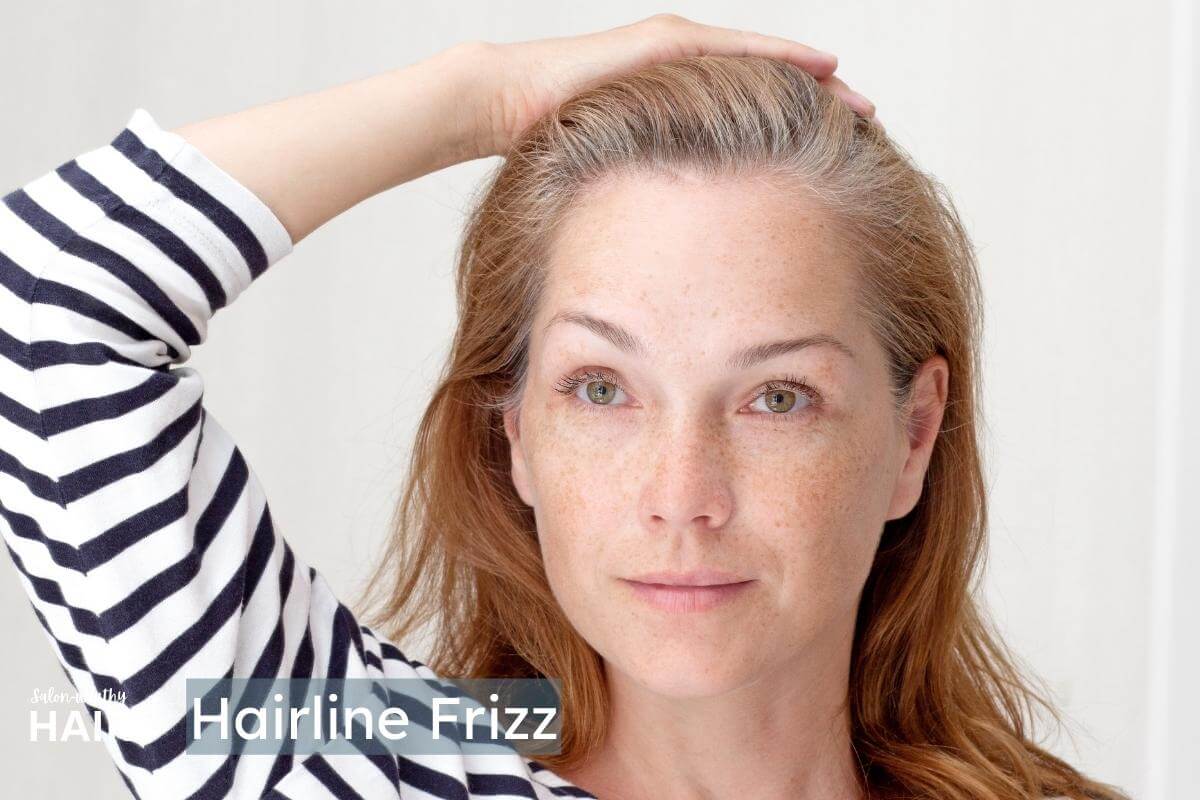
The hairline, or the strands of hair along the forehead, often features shorter, lighter strands referred to as baby hairs. These are wispier, shorter, and less dense than the rest of your hair, making them susceptible to frizz and a tendency to stick out. Their fragile nature makes them frizzy, particularly in humid conditions or when not moisturized.
To address hairline frizz:
- Apply a hair balm.
- Dampen the frizzy areas using a small amount of conditioner on your fingertips.
- Alternatively, mist a toothbrush with strong-hold hairspray and gently comb the baby hairs for a neater appearance.
L'ANZA Healing Smooth Smoother Hair Straightener Balm
Frizz on the Temples
Frizz often appears in the temple area because the hairs are finer in density and texture. These hairs are more easily agitated and frequently lack adequate product protection.
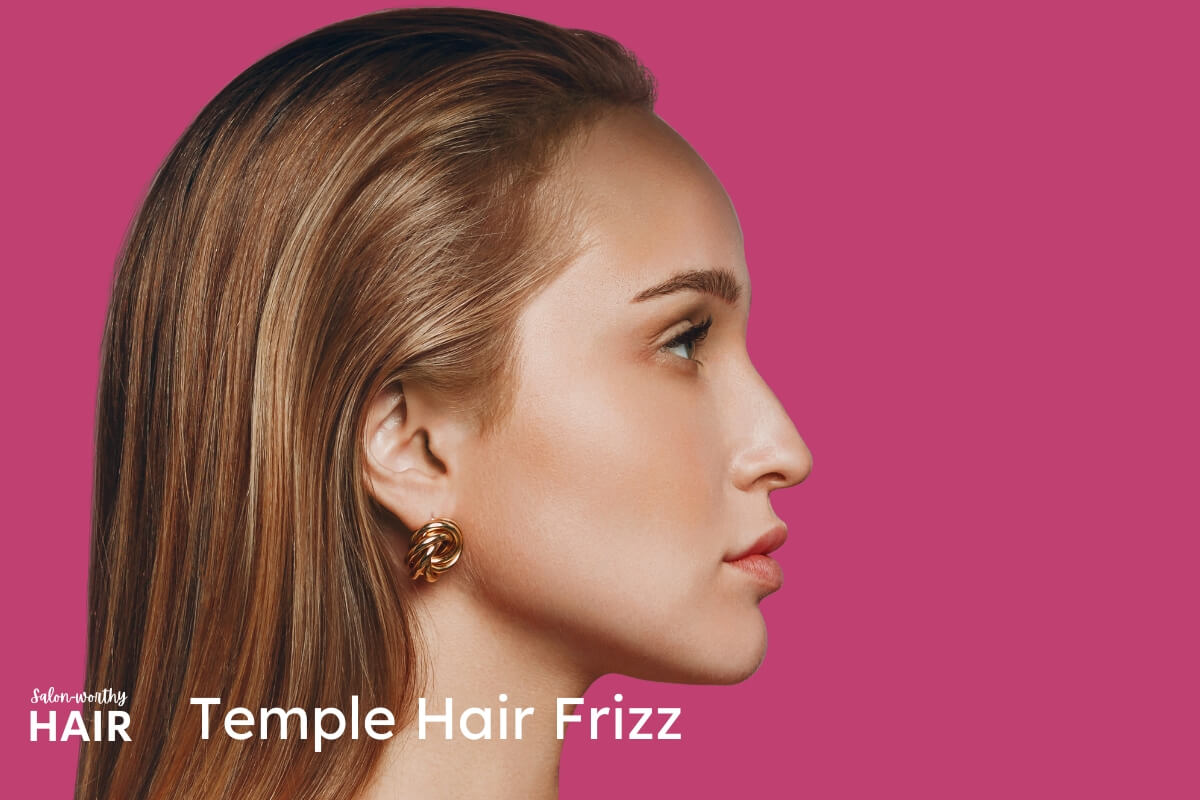
The hair on the sides of the head, between the forehead and the ears, is distinct in density and texture compared to other parts of the scalp. Referred to as temporal hairs, these strands are short, fine, and wispy, and they taper close to the skin at the hairline. Their reduced density and fineness mean they lack the weight and rigidity to stay smooth, making them prone to frizz.
Constant touching, rubbing, tucking, and friction from clothing can lead to frizz in temple hair. Habitual actions like twirling and scrunching can cause cuticle layers to lose their aligned structure. As these cuticles lift from the hair shaft, they allow moisture to penetrate freely, disrupting the hair’s natural moisture balance and leading to frizz.
Temple hairs often lack adequate product protection compared to other parts of the head. That’s because leave-in treatments like serums, creams, oils, gels, and anti-frizz sprays are typically applied generously to the densest areas of hair. Meanwhile, the temple hairs close to the face often get less product to prevent skin contact, which could lead to irritation or excess oiliness. Consequently, these hairs miss out on the protective components to keep them smooth and frizz-free.
To address temple hair frizz, use a temple hair balm specifically formulated for finer strands to provide moisture and smoothness.
You can also apply a light hold gel to tame flyaways and hold the temple hairs in place without weighing them down or making them appear greasy.
Lastly, it’s crucial to adopt a regimen of gentle handling, as rough or aggressive maneuvers can exacerbate frizz in this delicate area. Avoiding unnecessary tugging and being gentle during styling can make a significant difference in maintaining the smoothness of the temple hair.
PHYTO Phytodéfrisant Botanical Smoothing Balm
Frizzy Bangs
Bangs and fringes in hair get frizzy due to their constant exposure, frequent manipulation, and potential damage from heat styling and chemical treatments.
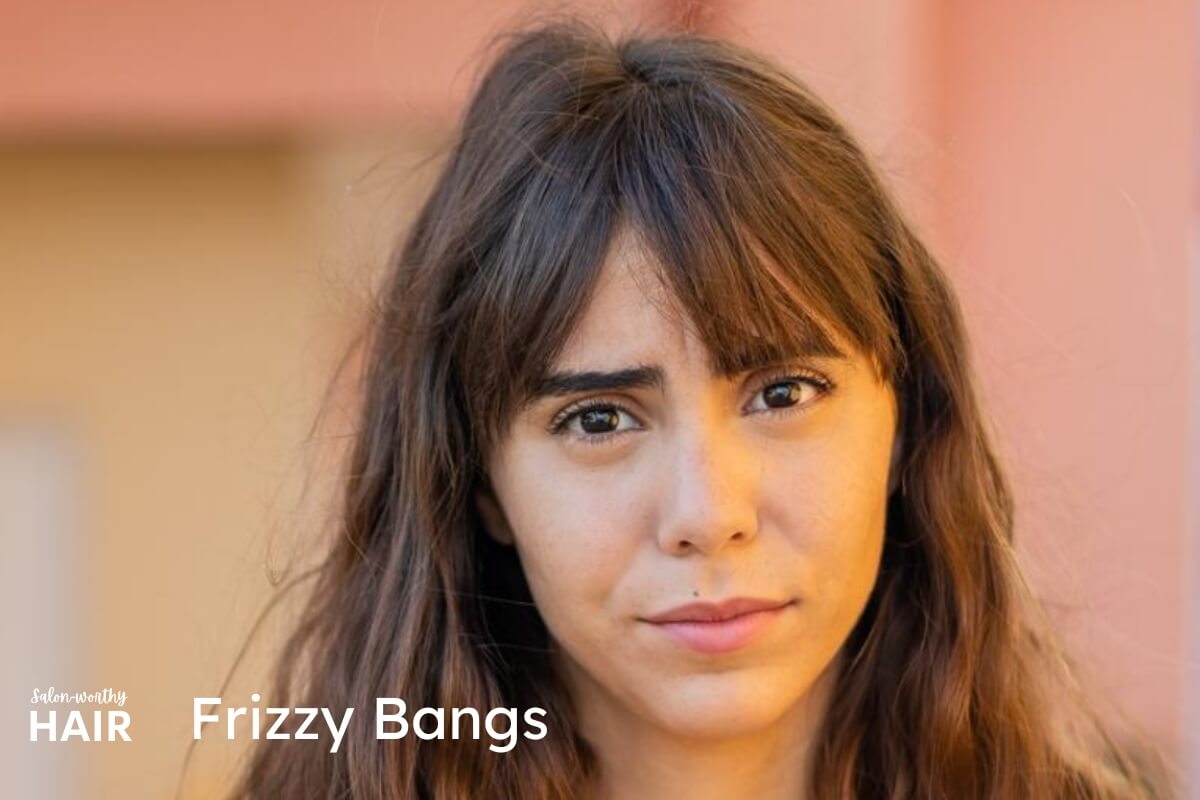
Bangs, also known as “fringes” or the “forelock,” are hairs that falls over the forehead. They can range from short, sitting above the eyebrows to long, touching the eyelashes or even the cheekbones. Whether cut straight across or angled, bangs stand out as a distinct styling feature, separated from the rest of the hair.
Given their prominent location on the forehead, bangs often become the focal point of any hairstyle. However, they are the first to encounter environmental elements like sun, wind, rain, and humidity. This constant exposure can lead to wear and tear, making them vulnerable to frizz.
Bangs frequently undergo significant styling due to their prominent position on the face. Tools like straighteners, curling irons, and hairdryers are commonly used to achieve the desired look. The repeated exposure and mechanical stress can lead to structural damage. As a result, bangs can become unruly and fail to maintain their intended direction or style.
To manage frizzy bangs, apply a texturizing spray for a light hold definition. Regular trims also help maintain a consistent length.
Kick Sea Salt Spray Natural Texturizing Spray
Also Check: How to fix frizzy bangs.Frizzy Edges
Hair around the edges often splays outward, creating a frizzy and flyaway halo. That’s because the hair in this area is delicate, has a finer texture, lacks length and weight, and is constantly exposed to elements and agitation.
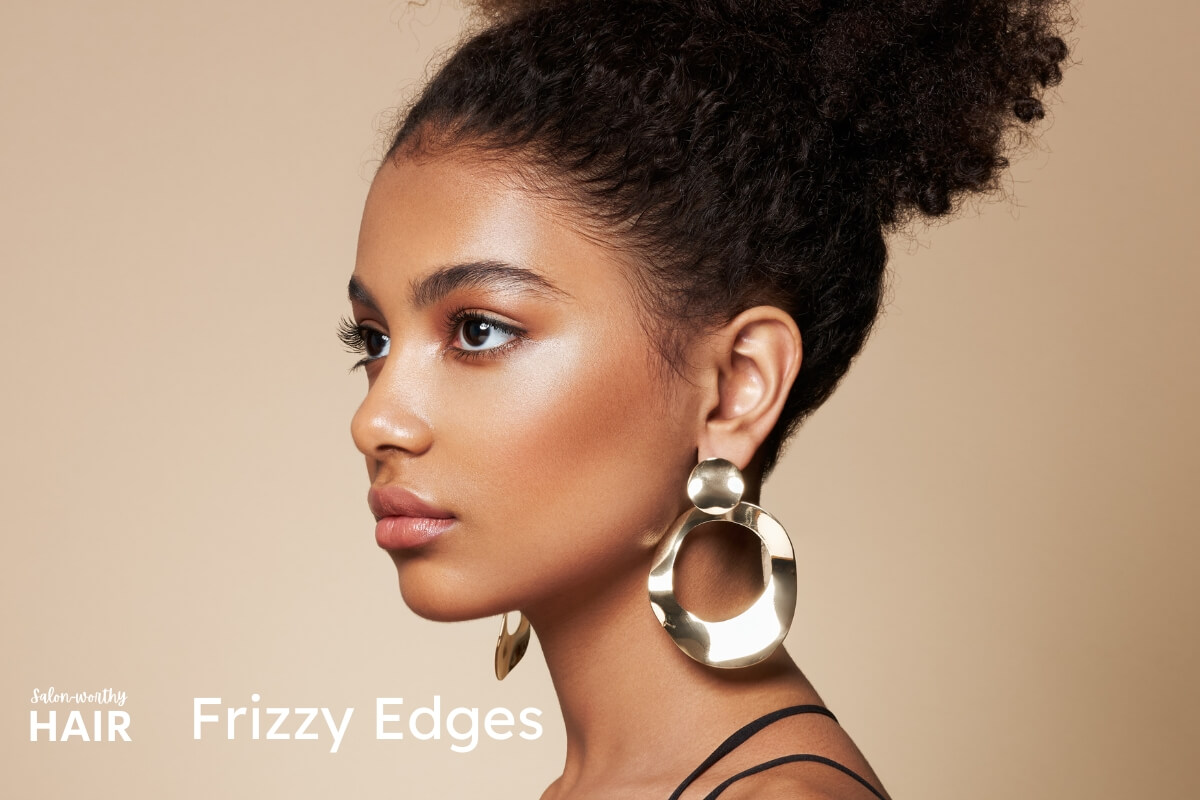
The hairs around the edges, especially those on the forehead, temples, and nape of the neck, are delicate and fine. These strands lack thickness and maturity, making them inherently fragile with less resilience and structure. Even minimal disturbances, like the brush of a collar or a light breeze, can cause these wispy hairs to lift and separate. Furthermore, the edges don’t receive as much scalp oil, making them drier.
The hair along the perimeter edges, at the front hairline, and the neckline often lack the necessary length and weight to remain smooth. These short, delicate strands don’t have the anchor that longer, heavier hair have. Without this weight, they easily drift, affected by minor air disturbances. Simple movements like tossing the head or a light breeze can cause these hairs to lift outward. Their lack of length means they don’t have the natural pull of gravity to keep them in place, often resulting in flyaways.
The hair on the outer edges is often more exposed and vulnerable than the rest of the head. Sun, wind, rain, and humidity can compromise the integrity of the cuticles over time. Additionally, the delicate edges face frequent friction from collars, earrings, glasses, and even our hands, which can progressively lift and separate the cuticle cells.
To tame frizzy edges, consider using an edge control gel or paste. These products offer a strong yet flexible hold, ensuring the edges remain smooth and maintain their styled shape. Additionally, edge control products contain moisturizing and nourishing agents that combat dryness and breakage, delivering a polished and neat appearance.
Edge control products also prevent the edges from frizzing or curling up throughout the day.
PATTERN by Tracee Ellis Ross Edge Control
Frizz at the Nape of the Neck
Hair at the nape of the neck area often experiences frizz due to friction from clothing and accessories that leads to cuticle disruption.
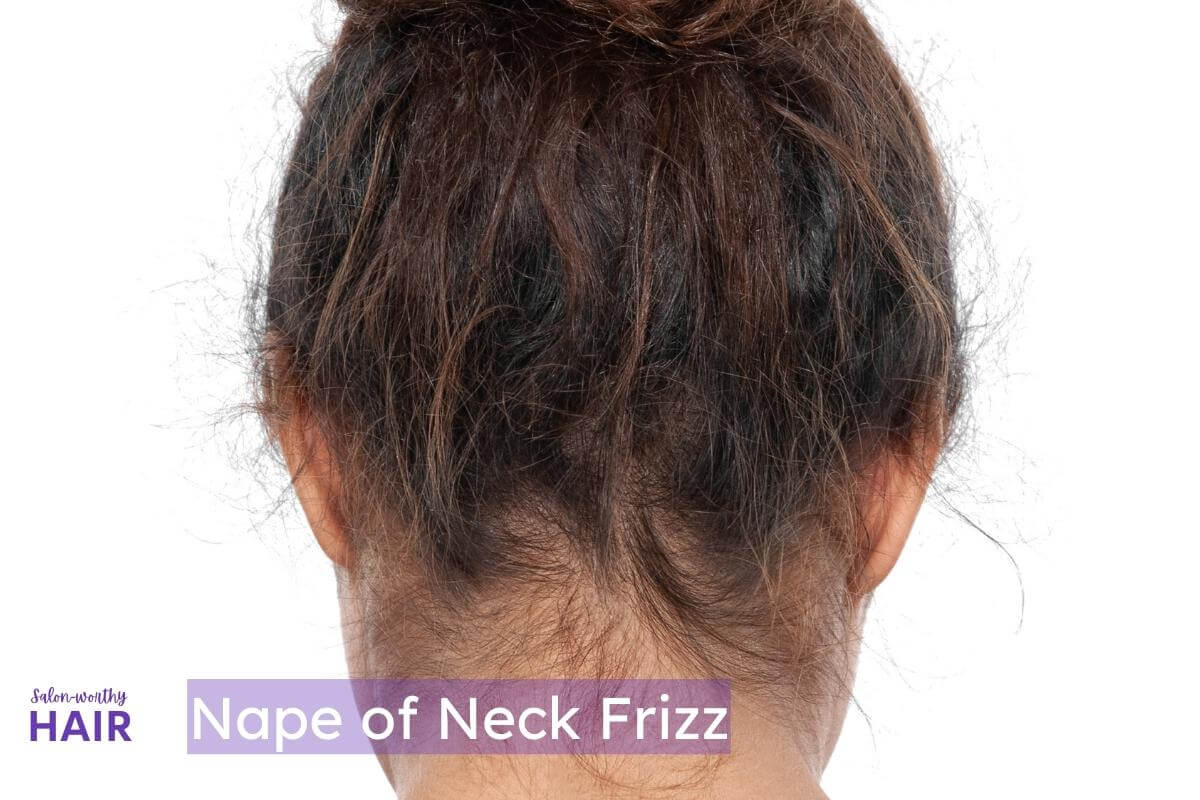
The nape area refers to the lower part of the hair at the back of the neck. Often hidden beneath longer hairstyles, this area is especially vulnerable due to its exposure to friction from clothing, accessories, and even from lying down. Such continuous abrasion can disrupt the hair’s natural cuticle layer, leading to tangles, increased frizz, and potential breakage.
To combat frizz in the nape area:
- Opt for silk or satin scarves as they produce less friction than cotton or synthetic materials, thus minimizing the risk of tangles and frizz.
- Choose hair accessories with a smooth finish or those covered in friction-reducing fabric. For instance, satin-covered scrunchies, hairbands, or clasps are ideal choices.
Mulberry Silk Scarf
Frizz at the Back of the Head
Frizz at the back of the head often results from the natural hair growth direction in that area, compounded by friction against surfaces such as pillowcases during sleep or relaxation.
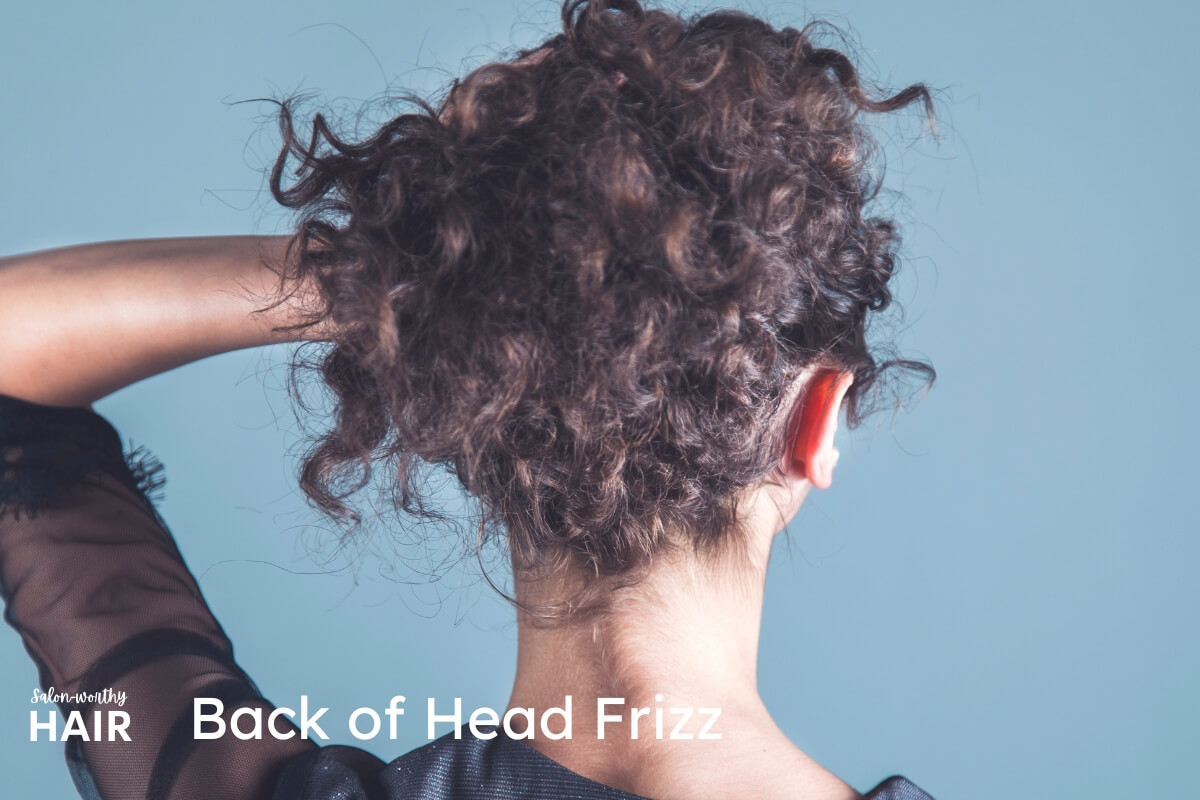
Hairs on the back of the head can grow in multiple directions, creating natural swirl patterns or “cowlicks.” This multidirectional growth leads to hairs pushing against one another, resulting in entanglement, raised cuticles, and frizz. Anatomically, the back of the head is known as the occipital region. It plays a central role in how humans rest, sleep, or relax. Due to our postural habits, this region frequently comes into contact with surfaces, especially when lying on a bed or couch or during certain exercises and relaxation techniques.
Pillowcases are crucial for hair at the back of the head. While traditional pillowcases made from materials like cotton are comfortable, their woven texture can grip and tug at hair strands. Continuous nightly friction caused by these movements can damage the hair’s cuticle. This friction-induced disturbance often results in the dreaded bedhead frizz.
Many haircare experts recommend silk or satin pillowcases as alternatives, as their smoother textures reduce friction and are less absorbent, retaining the hair’s natural moisture and oils.
To prevent frizz at the back of your head, adopt the directional blow-drying technique. This method involves setting the hair direction downward to smooth the cuticles. Additionally, consider investing in a silk pillowcase. Unlike cotton or other common materials, silk reduces friction between your hair and the pillow, resulting in fewer tangles and reduced breakage.
Slip Silk Queen Pillowcase
Frizz on the Surface of the Hair
Surface frizz is uncontrolled and errant hair strands that deviate from the main body of the hairstyle, creating a fuzzy or static appearance around your head. This frizz is typically caused by dry conditions, leading to a buildup of static electricity in the hair. Static makes hair strands repel each other and separate to stand out instead of lying flat and aligned.
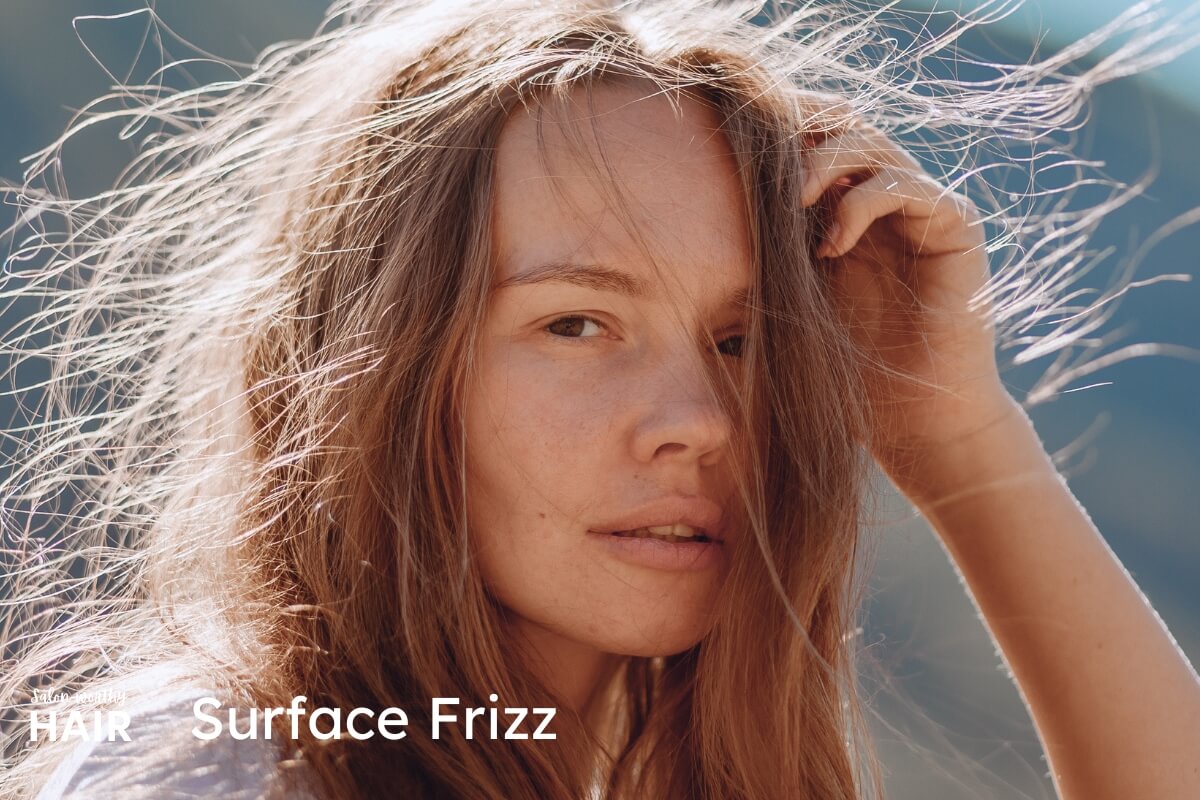
Surface frizz occurs only on the outer layers of the hair, not affecting the layers underneath. The surface area is essentially the silhouette or outline of a hairstyle, which, when viewed from the outside, determines the visible shape and texture of one’s hair.
Dry weather conditions can lead to static electricity in the hair. Instead of the smooth, cohesive appearance of well-moisturized hair, static chargse make hair strands “stick out” in various directions. Combined with a roughened, damaged cuticle, the repulsion leads to the individual strands separating and pointing erratically. The result is what’s commonly referred to as surface frizz.
It’s essential to smooth and seal the cuticle to combat static electricity in hair. Smoothing helps weigh the hair down, countering the repelling effect caused by static charges. Additionally, reducing friction and avoiding dry conditions can help diminish the onset of electrical frizz.
To tame surface frizz, consider using anti-static products. These products neutralize static electricity thanks to anti-static agents like glycerin or citric acid.
Anti-Static Spray for Hair
Frizzy Hair Underneath
The hair underneath and on the undersides get frizzy due to different textures and growth patterns, product buildup, susceptibility to tangles, and oversight during product application.
The hair underneath (bottom layer) is closer to the scalp and covered by the top, more visible layers of hair. The hair on the undersides grows at an angle following the contour of the head shape. These layers, nestled beneath the surface and conforming to the head’s curvature, have different texture and growth patterns than the top layer of the hair.
The bottom layers of hair are relatively more youthful cince they are the newest growths. These virgin underlayer hairs reflect one’s true natural texture since they have not been subjected to the same wear and tear as the mature hair on top. The top layers have a longer age and more accumulated exposure to chemical treatments, heat styling, brushing, and environmental damage. That’s why, hair can be frizzier on top but smooth underneath.
The top layers lose their natural texture compared to the fresh, untouched hair on the bottom. The mismatch between the younger hair on the bottom and the damaged, processed hair on top can create a frizzy, poofy appearance where the layers meet.
The natural growth patterns of underlayer hair can cause bottom-layer frizz due to multidirectional friction between converging strands, disturbing the cuticle and tangling hair. For individuals with curly hair, the tight shrinkage near the scalp transitions to looser coils on the ends from length and weight. This curl mismatch strains the hair’s cuticle through opposing forces.
Products that aren’t thoroughly rinsed or cleansed from the hair can attract dirt and pollutants in the hair underneath the top layers. Hair products like conditioners, oils, gels, and those that contain silicone can accumulate at the base of the hair (near the roots) if not clarified regularly with a deep cleansing shampoo. The buildup near the scalp can cause causing tangles, matted hair, and lack of curl clumping.
But having said that, the hair underneath must not be neglected during product application. You must find the right balance between what product and how much to apply.
Some may need to pay more attention to the importance of adequately moisturizing the hair near the roots, causing an uneven distribution of products designed to moisturize, protect, or smooth the hair. Without the protective and smoothing properties of hair products, hair near the roots can become prone to frizz compared to the top layers that receive regular product application.
To stop frizz in the underlayers, use a clarifying shampoo. A clarifying removes styling product buildup to prevent the hairs from weighing down.
Moroccanoil Clarifying Shampoo
Why Only One Patch Of Hair Gets Frizzy?
You can get frizzy hair in patches because that patch may have more split ends, porous hair, different growth patterns, cuticle damage, or neglect during product application. Patchy frizz can also result from brushing, heat styling, or rubbing against clothes in the same spot.
Frizzy Hair in Parts Requires Targeted Products
Localized frizz requires targeted care with specialized products. Whether it’s the crown, parting, hairline, ends, or an isolated patch, each area’s unique needs and damage profile should be assessed.
While a nourishing shampoo and conditioner support overall hair health, frizz-prone zones often benefit from additional focused solutions. Using the right product for each problem area and adapting routines based on changes over time is key to managing localized frizz. A strategic regimen catering to the area-specific causes can tame even stubborn frizz spots.
About the Author
 Shehnaz Shirazi
Shehnaz ShiraziShehnaz Shirazi has been writing in the beauty and cosmetics industry for over 8 years, sharing her expansive hair care and beauty knowledge. Shehnaz researches and tests new hair care trends and publishes her insights here.




